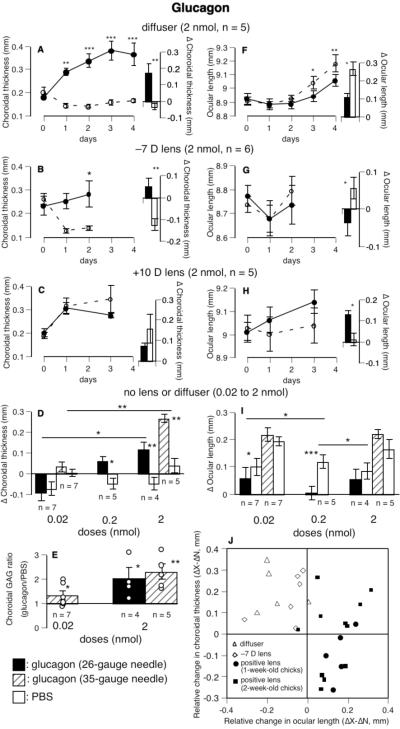FIGURE 1.
The effects of glucagon on ocular length and the thickness and GAG synthesis of the choroid. Glucagon increased choroidal thickness (A, B, D, and J) and decreased the rate of ocular elongation (F, G, I, and J) in eyes wearing diffusers, -7 D lenses, or no devices. The opposite effect was found in eyes wearing positive lenses (C, H, and J). Glucagon also increased the rate of choroidal GAG synthesis (E) in eyes without lenses or diffusers. Panel J shows that, in eyes wearing positive lenses, glucagon (2 nmol) increased the rate of ocular elongation in nearly all birds and reduced choroidal thickening in half of them. Panel J includes 7 birds (five 1-week-old and two 2-week-old) from pilot experiments not shown in Table 1. Bar-charts show the mean changes and SEMs over the course of the experiments shown in the line-graphs, in which solid and interrupted lines show the time course of the experimental and fellow eyes, respectively. For choroidal GAG synthesis, the ratios of the scintillation counts in paired eyes (glucagon/PBS) of individual chicks (circles) are superimposed on the mean (bars) and SEM of each group. Analysis of Variance (ANOVA) with Bonferroni post hoc tests were used to test the statistical significance of interocular difference (X-N) among different days within a group with respect to day 0 (asterisks on line-graphs), and of relative changes (ΔX-ΔN) among the different doses (asterisks over horizontal lines in panels D and I). For ocular length and choroidal thickness, asterisks over bars indicate paired, 1-tailed Student t-tests comparing changes in experimental and fellow eyes, except for panels C and H, in which paired, 2-tailed Student t-tests were used. For GAG synthesis, one-sample t-tests were used to compare the ratio of the counts from paired eyes (glucagon/PBS, or X/N) with a value of 1. *p < 0.05, **p < 0.01, ***p < 0.001.

